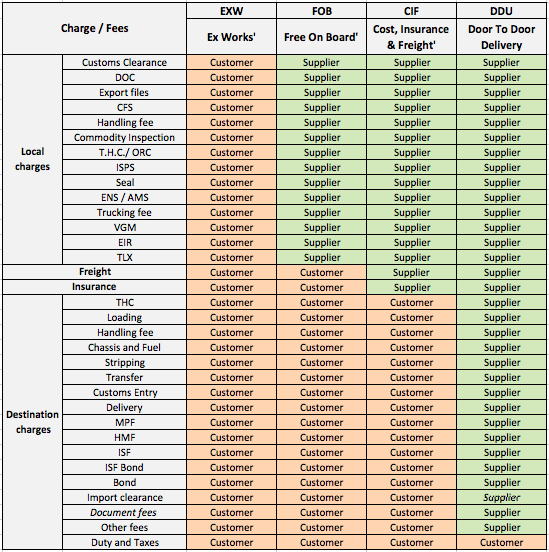By Fabien Gaussorgues
Many companies see the lower cost of manufacturing in China, but sometimes they forget to factor in the logistical costs. In some cases, logistical costs can be higher than the price of products!
In this article we will cover some of the basics every importer needs to know.
1. Frequently used incoterms
The first step is to decide on shipping terms with your suppliers. Here are the 4 most common incoterms in China, sorted from the highest to the lowest involvement on the buyer’s side.
- EXW: the buyer picks up the goods at the factory, buys them in the country of manufacturing, and takes care of the whole export process. Note that VAT is usually included in the EXW price offered by the supplier, and a part of it can generally be deducted during the export process. For most importers, buying in EXW terms doesn’t make sense.
- FOB: the buyer only needs to manage the transportation from a Chinese port, and the import process into the country of final sale. This is the most common incoterm chosen by importers. This way, the buyer controls the international transport (including allowing the supplier to ship the goods out). Do be warned that there is a small risk that you need to cover yourself against when shipping FOB.
- CIF: The buyer gets the products at the destination port (usually the closest to the buyer’s warehouse). A frequent downside is higher local fees, as explained here.
- DDU: the goods arrive at the buyer’s warehouse, and the buyer only pays for import duties. This is often a good option too.
(By the way, you don’t have to use the standard ‘incoterms’, and some sophisticated buyers include other terms in their contracts.)
2. Understanding quotations from freight forwarders
Most quotations are divided in 3 sections, which helps the importer understand and compare the quotations:
- Origin fees, from the factory to the warehouse next to the port/airport;
- International transportation fees;
- Destination fees, from the buyer’s closest port/airport to the buyer’s warehouse.
For small shipments, the origin and destination fees can be much higher than international transportation! For that reason, some freight forwarders mention only the transportation fee in order to attract new clients. That’s a trap.
A quotation for logistical services can be quite difficult to understand. Each company has a different way of providing information.
3. What fees should you pay?
The table below illustrates what fees apply during the shipment process and who should pay them, in function of the incoterm chosen.
4. Understanding the industry jargon
Here are some explanations:
- Customs Clearance: usually covers 5 items (5 SKUs), and there is surcharge for extra items.
- DOC: stands for “document”, and usually means Bill of Lading (necessary for releasing your goods at delivery).
- Export files: a set of files should be provided by the shipper, including the commercial invoice and the packing list.
- CFS: stands for “container freight station”. Comes up in LCL shipping (when your goods don’t fill the container up and other goods are also placed in the same container). It corresponds to the cost of packing the goods into a container.
- Commodity Inspection: some cargos need this for export from China. As a buyer, you should check this point with the supplier or forwarder.
- THC/ORC: stands for “Terminal Handling Charge. This applies to FCL shipping (full container).
- ISPS: International Ship and Port Facility Security Code. It refers to coordination between countries, to ensure transportation safety.
- Seal: it is basically the lock of the container. Each seal has a unique number.
- ENS/AMS: ENS is for European Union; AMS is for North America. It stands for “Entry Summary Declaration” or “Automated Manifest System. It is related to those countries’ security.
- VGM: stands for “Verified Gross Mass”. It is the control of the total weight of the shipment.
- EIR: stands for “Equipment Interchange Receipt”. It is a card issued by the terminal to the exporter/shipper after all costs are paid.
- TLX: it stands for the “Telex Release” of the original bill of lading which is an important document to release the goods.
- MPF: this is USA specific. It stands for “Merchandise Processing Fee”. It is a sort of customs fee, to check the products’ compliance.
- HMF: this is also USA specific. It stands for “Harbor Maintenance Fee”. It cover the maintenance costs of the terminal.
- ISF: stands for “Importer Security Filing”. A Form containing a list of 10 elements has to be provided to US customs before arrival.
Do you have to study all these lines one by one every time? Of course not.
However, it will help you understand the quotations from logistics providers. And you might have a few surprises!
Different quotes will include different amounts for elements that are country-specific and should be fixed. Obviously, freight forwarders manipulate quotations to confuse buyers and avoid excessive transparency.
More importantly, the terms used by your suppliers can have a strong impact on the costs of logistics. In the majority of cases, the importer’s interest is to work under FOB, especially if they have limited experience importing goods. FOB is widely accepted in China.
CIF and DDU might look as a better deal, but often includes an extra margin from your supplier on the transportation cost.

